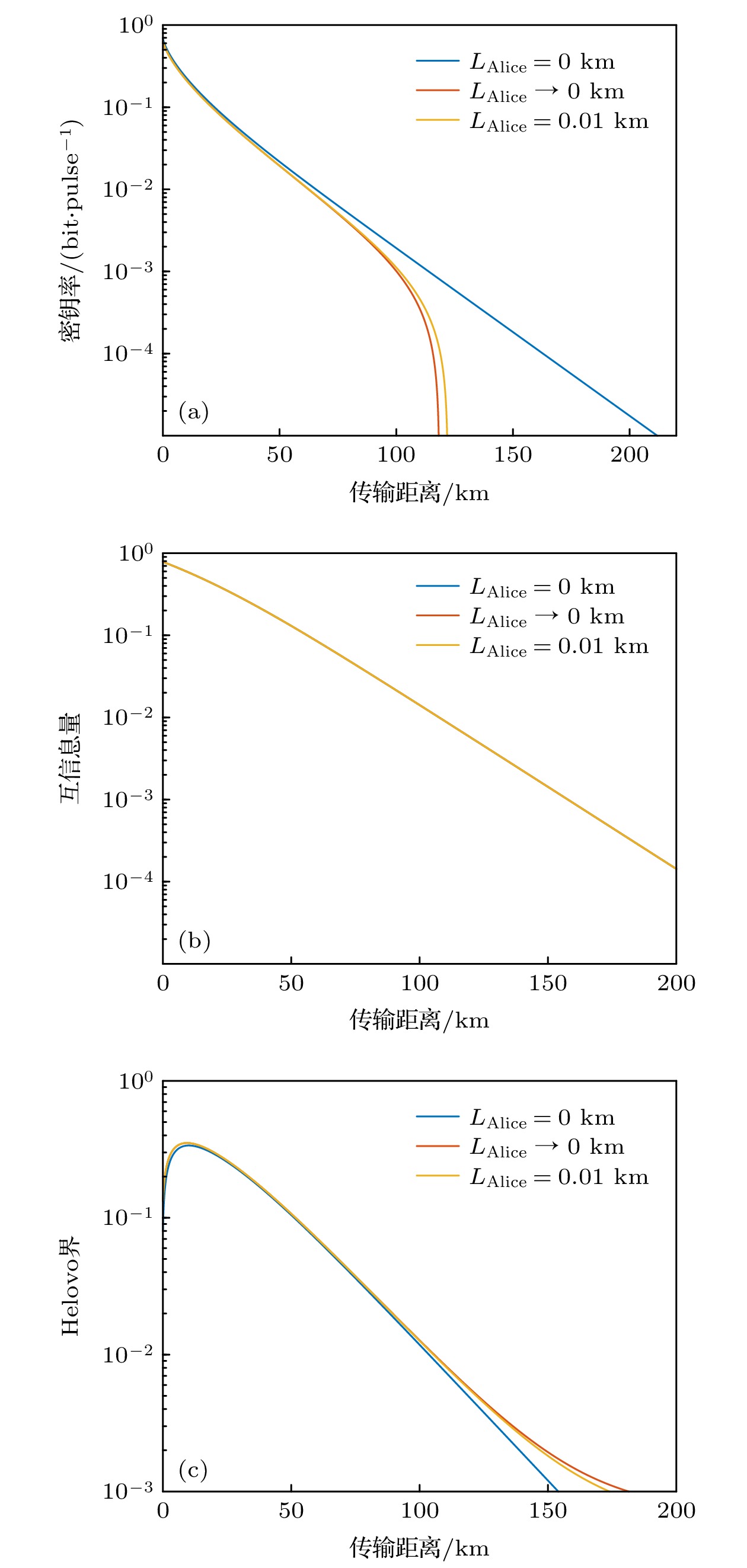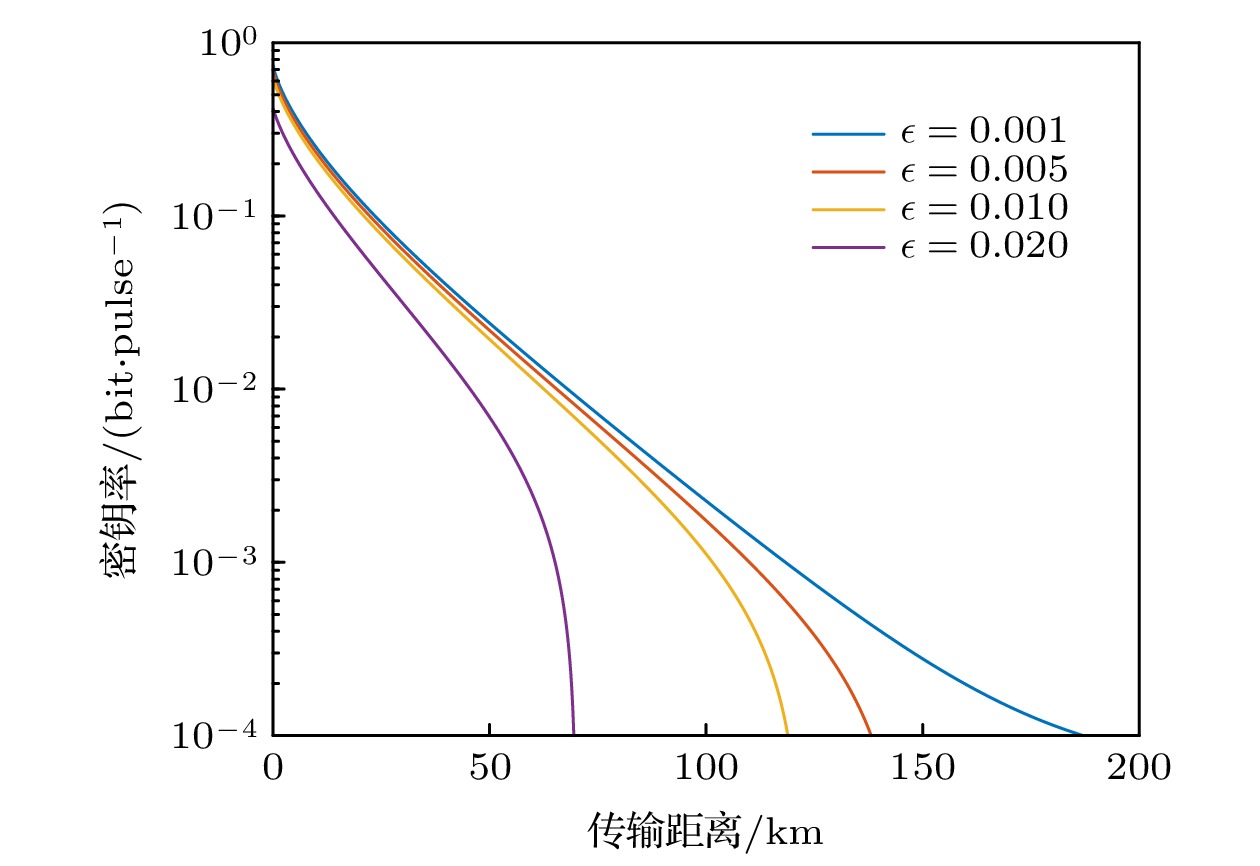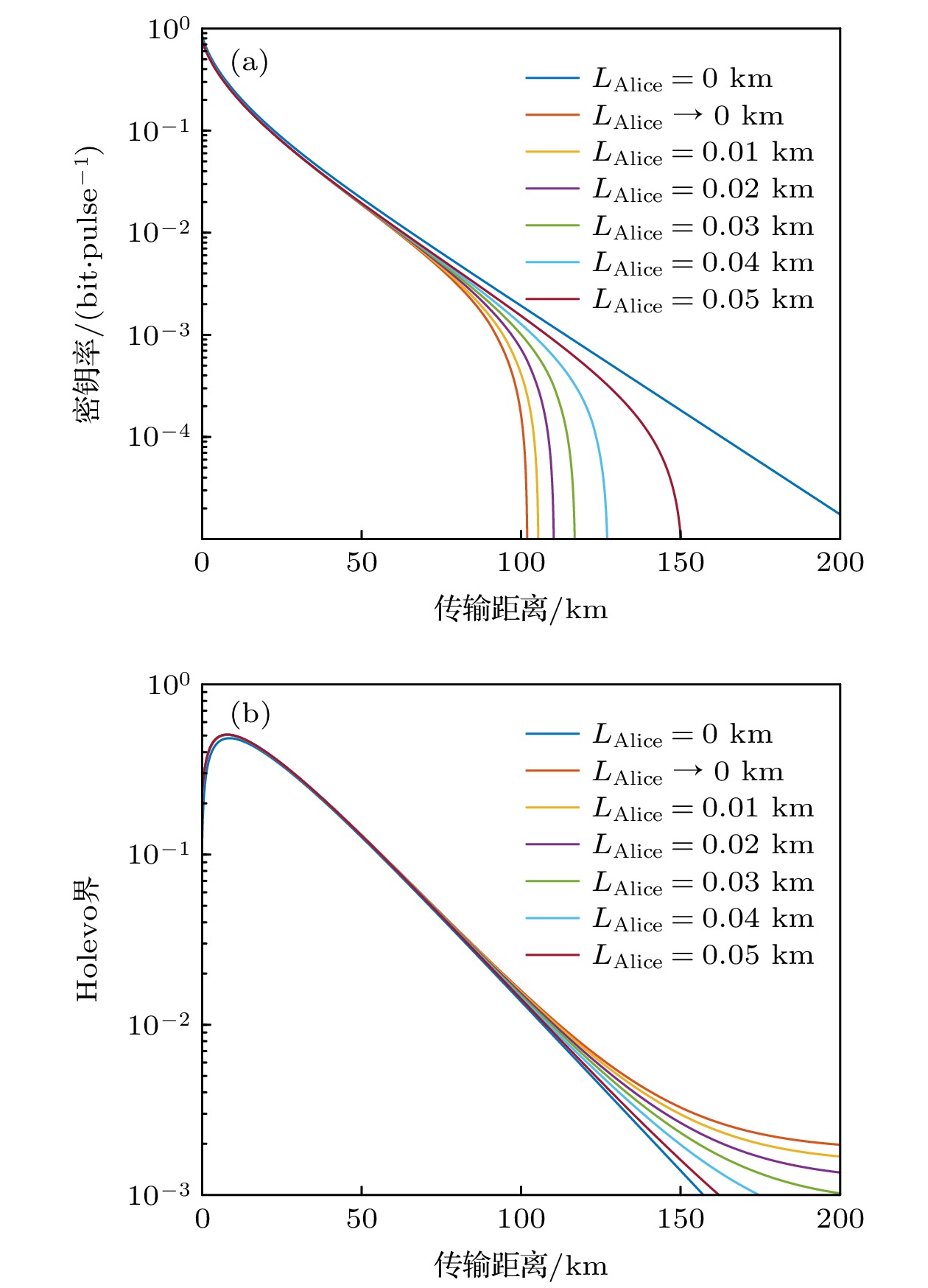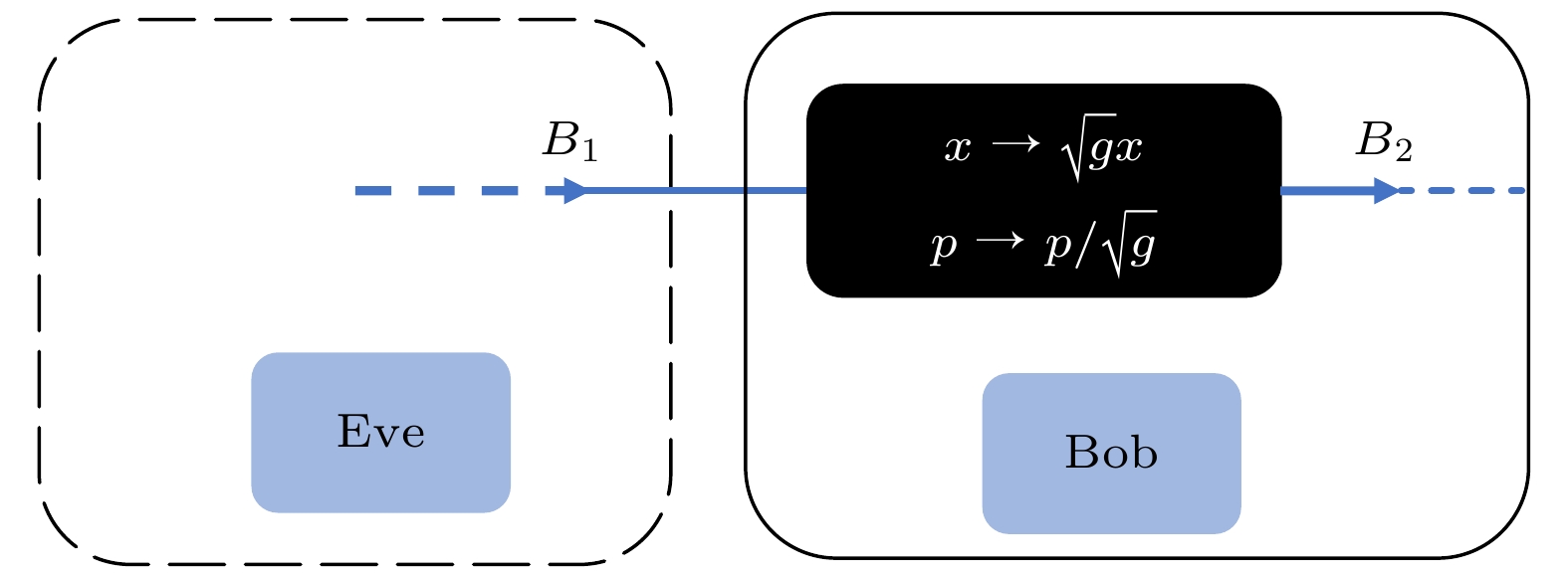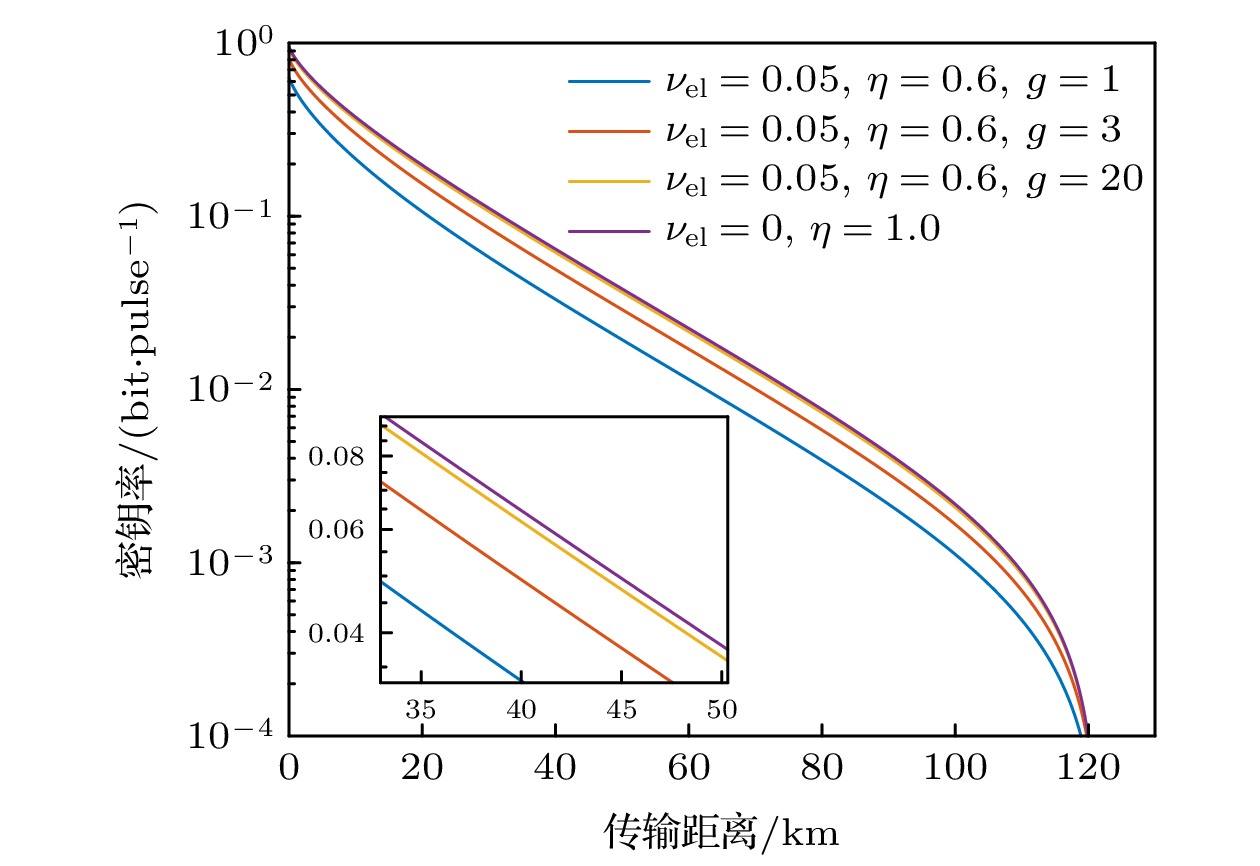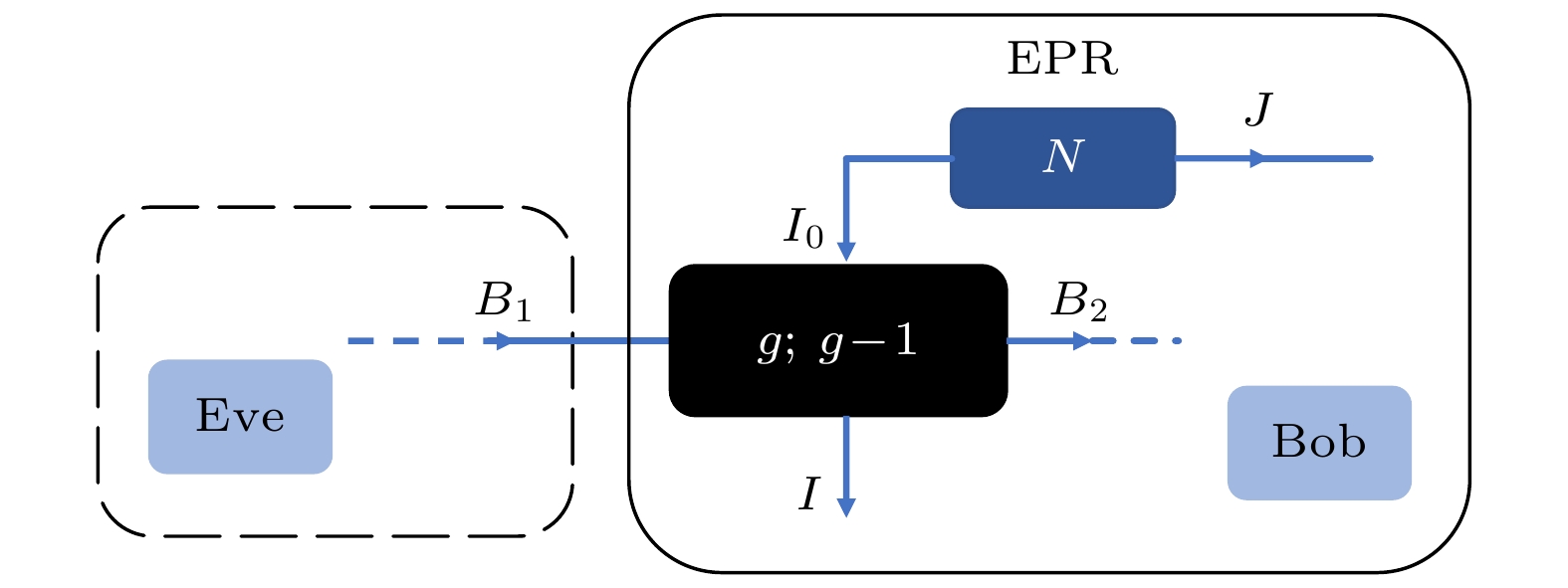-
在实际的量子通信系统中, 连续变量量子密钥分发的信源安全可能会因为器件的缺陷或隐藏的攻击而受到威胁. 针对这个问题, 本文提出了基于不可信纠缠源的高斯调制连续变量量子密钥分发方案, 通过将高斯纠缠源置于不可信的量子信道来模拟纠缠源被攻击者所控制的场景, 从而验证实际复杂环境下高斯调制连续变量量子密钥分发的安全性. 本文详细分析不可信纠缠源对系统安全性的影响并引入了两种光学放大器来辅助提升所提方案的实际性能. 仿真实验结果表明, 本文所提方案即使在高斯纠缠源不可信的情况下仍然能够产生安全的量子密钥, 同时, 光学放大器也能够有效提升接收端探测器的量子效率. 该工作旨在推动高斯调制连续变量量子密钥分发系统的实用化进程, 为高斯调制连续变量量子密钥分发系统的实际部署和应用提供理论指导.
-
关键词:
- 连续变量量子密钥分发 /
- 不可信纠缠源 /
- 光学放大器 /
- 量子通信
In a practical quantum communication system, the security of signal source of continuous-variable quantum key distribution may be jeopardized due to device flaws and hidden attacks. In this paper, an improved scheme for Gaussian-modulated continuous-variable quantum key distribution based on an untrusted entangled source is proposed. In particular, the entanglement source is placed in an untrusted quantum channel to simulate that it is controlled by an eavesdropper, thereby verifying the security of Gaussian-modulated continuous-variable quantum key distribution in a complex environment. This work in detail analyzes the influence of untrusted entanglement source on practical Gaussian-modulated continuous-variable quantum key distribution system, and the numerical simulation shows that the performance of Gaussian-modulated continuous-variable quantum key distribution will dramatically decrease once the entanglement source has moved out of the sender, and it will slightly rise as the untrusted entanglement source slowly moves away from the sender. This paper further introduces two kinds of optical amplifiers, which are phase-sensitive amplifier and phase-insensitive amplifier, to compensate for the imperfection of the coherent detector. These amplifiers are beneficial to enhancing the quantum efficiency of the receiver’s detector. Specifically, the security key rate of Gaussian-modulated continuous-variable quantum key distribution with homodyne detection can be well improved by phase-sensitive amplifier, and the security key rate of Gaussian-modulated continuous-variable quantum key distribution with heterodyne detection can be well improved by phase-insensitive amplifier. To summary, this paper proposes a scheme for Gaussian-modulated continuous-variable quantum key distribution with untrusted entanglement source, experimental results show that the proposed scheme can generate secure quantum keys even if the Gaussian entanglement source is untrusted, and the two optical amplifiers can effectively improve the quantum efficiency of the detector at the receiver. This work aims to promote the practical process of the Gaussian-modulated continuous-variable quantum key distribution system and provide theoretical guidance for the practical implementation and application of the Gaussian-modulated continuous-variable quantum key distribution system.-
Keywords:
- continuous-variable quantum key distribution /
- untrusted entanglement source /
- optical amplifier /
- quantum communication
[1] Zhou N R, Li J F, Yu Z B, Gong L H, Farouk A 2016 Quantum Inf. Process 16 4
[2] Scarani V, Bechmann-Pasquinucci H, Cerf N J, Dušek M, Lütkenhaus N, Peev M 2009 Rev. Mod. Phys. 81 1301
 Google Scholar
Google Scholar
[3] Gisin N, Ribordy G, Tittel W, Zbinden H 2002 Rev. Mod. Phys. 74 145
 Google Scholar
Google Scholar
[4] Gong L H, Li J F, Zhou N R 2018 Laser Phys. Lett. 15 105204
 Google Scholar
Google Scholar
[5] Liao Q, Liu H J, Zhu L J, Guo Y 2021 Phys. Rev. A 103 032410
 Google Scholar
Google Scholar
[6] Liao Q, Liu H J, Gong Y P, Wang Z, Peng Q Q, Guo Y 2022 Opt. Express 30 3876
 Google Scholar
Google Scholar
[7] 宋汉冲, 龚黎华, 周南润 2012 物理学报 61 154206
 Google Scholar
Google Scholar
Song H C, Gong L H, Zhou N R 2012 Acta Phys. Sin. 61 154206
 Google Scholar
Google Scholar
[8] Zhou N R, Wang L J, Ding J, Gong L H, Zuo X W 2010 Int. J. Theor. Phys. 49 2035
 Google Scholar
Google Scholar
[9] Guo Y, Liao Q, Wang Y J, Huang D, Huang P, Zeng G H 2017 Phys. Rev. A 95 032304
 Google Scholar
Google Scholar
[10] 钟海, 叶炜, 吴晓东, 郭迎 2021 物理学报 70 020301
 Google Scholar
Google Scholar
Zhong H, Ye W, Wu X D, Guo Y 2021 Acta Phys. Sin. 70 020301
 Google Scholar
Google Scholar
[11] Lance A M, Symul T, Sharma V, Weedbrook C, Ralph T C, Lam P K 2005 Phys. Rev. Lett. 95 180503
 Google Scholar
Google Scholar
[12] Ma X C, Sun S H, Jiang M S, Gui M, Liang L M 2014 Phys. Rev. A 89 042335
 Google Scholar
Google Scholar
[13] Grosshans F, Grangier P 2002 Phys. Rev. Lett. 88 057902
 Google Scholar
Google Scholar
[14] Leverrier A 2015 Phys. Rev. Lett. 114 070501
 Google Scholar
Google Scholar
[15] Leverrier A, Grosshans F, Grangier P 2010 Phys. Rev. A 81 062343
 Google Scholar
Google Scholar
[16] Jouguet P, Kunz-Jacques S, Diamanti E 2013 Phys. Rev. A 87 062313
 Google Scholar
Google Scholar
[17] Ma X C, Sun S H, Jiang M S, Liang L M 2013 Phys. Rev. A 88 022339
 Google Scholar
Google Scholar
[18] Qin H, Kumar R, Alléaume R 2016 Phys. Rev. A 94 012325
 Google Scholar
Google Scholar
[19] Huang J Z, Weedbrook C, Yin Z Q, Wang S, Li H W, Chen W, Guo G C, Han Z F 2013 Phys. Rev. A 87 062329
 Google Scholar
Google Scholar
[20] Ma X C, Sun S H, Jiang M S, Liang L M 2013 Phys. Rev. A 87 052309
 Google Scholar
Google Scholar
[21] Qin H, Kumar R, Makarov V, Alléaume R 2018 Phys. Rev. A 98 012312
 Google Scholar
Google Scholar
[22] Zhou N R, Zhang T F, Xie X W, Wu J Y 2023 Signal Process. Image Commun. 110 116891
 Google Scholar
Google Scholar
[23] Liao Q, Xiao G, Zhong H, Guo Y 2020 New J. Phys. 22 083086
 Google Scholar
Google Scholar
[24] Weedbrook C 2013 Phys. Rev. A 87 022308
 Google Scholar
Google Scholar
[25] Liao Q, Xiao G, Xu C G, Xu Y, Guo Y 2020 Phys. Rev. A 102 032604
 Google Scholar
Google Scholar
[26] Fossier S, Diamanti E, Debuisschert T, Tualle-Brouri R, Grangier P 2009 J. Phys. B: At., Mol. Opt. Phys. 42 114014
 Google Scholar
Google Scholar
[27] Zhang H, Fang J, He G Q 2012 Phys. Rev. A 86 022338
 Google Scholar
Google Scholar
[28] Wu X D, Wang Y J, Liao Q, Zhong H, Guo Y 2019 Entropy 21 333
 Google Scholar
Google Scholar
[29] Pirandola S, Braunstein S L, Lloyd S 2008 Phys. Rev. Lett. 101 200504
[30] García-Patrón R, Cerf N J 2006 Phys. Rev. Lett. 97 190503
 Google Scholar
Google Scholar
[31] Navascués M, Grosshans F, Acín A 2006 Phys. Rev. Lett. 97 190502
 Google Scholar
Google Scholar
[32] Huang D, Huang P, Lin D K, Zeng G H 2016 Sci. Rep. 6 19201
 Google Scholar
Google Scholar
[33] Huang D, Lin D K, Wang C, Liu W Q, Fang S H, Peng J Y, Huang P, Zeng G H 2015 Opt. Express 23 017511
 Google Scholar
Google Scholar
[34] Jouguet P, Kunz-Jacques S, Leverrier A, Grangier P, Diamanti E 2013 Nat. Photonics 7 378
 Google Scholar
Google Scholar
[35] Huang L Y, Zhang Y C, Huang Y D, Jiang T W, Yu S 2019 Phys. B: At. Mol. Opt. Phys. 52 225502
 Google Scholar
Google Scholar
[36] Zhang Y C, Li Z Y, Weedbrook C, Yu S, Gu W Y, Sun M Z, Peng X, Guo H 2014 J. Phys. B: At., Mol. Opt. Phys. 47 035501
 Google Scholar
Google Scholar
[37] Guo Y, Li R J, Liao Q, Zhou J, Huang D 2018 Phys. Lett. A 382 372
 Google Scholar
Google Scholar
[38] Blandino R, Leverrier A, Barbieri M, Etesse J, Grangier P, Tualle-Brouri R 2012 Phys. Rev. A 86 012327
 Google Scholar
Google Scholar
[39] Bencheikh K, Lopez O, Abram I, Levenson J A 1995 Appl. Phys. Lett. 66 399
 Google Scholar
Google Scholar
-
图 3 零差探测下不可信纠缠源的GMCVQKD方案的与原始GMCVQKD方案的性能对比 (a) 两种方案的安全密钥率与传输距离的关系; (b)两种方案的互信量与传输距离的关系; (c)两种方案的Holevo界与传输距离的关系
Fig. 3. The performance comparison between the GMCVQKD scheme with an untrusted entanglement source and the original GMCVQKD scheme under homodyne detection: (a) The relationship between the security key rate and transmission distance of the two schemes; (b) the relationship between mutual information and transmission distance of the two schemes; (c) the relationship between Holevo bound and transmission distance of two schemes.
图 4 零差探测下基于不可信纠缠源的GMCVQKD方案在不同纠缠源距离下的性能 (a)所提方案的安全密钥率与传输距离的关系; (b)所提方案的Holevo界与传输距离的关系
Fig. 4. Performance of the GMCVQKD scheme based on an untrusted entanglement source with homodyne detection at different entanglement source distances: (a) Relationship between the security key rate of the proposed scheme and the transmission distance; (b) relationship between the Holevo bound of the proposed scheme and the transmission distance.
图 6 外差探测下基于不可信纠缠源的GMCVQKD方案在不同纠缠源距离下的性能 (a) 所提方案的安全密钥率与传输距离的关系; (b)所提方案的Holevo界与传输距离的关系
Fig. 6. Performance of the GMCVQKD scheme based on an untrusted entanglement source with heterodyne detection at different entanglement source distances: (a) Relationship between the security key rate of the proposed scheme and the transmission distance; (b) relationship between the Holevo bound of the proposed scheme and the transmission distance.
-
[1] Zhou N R, Li J F, Yu Z B, Gong L H, Farouk A 2016 Quantum Inf. Process 16 4
[2] Scarani V, Bechmann-Pasquinucci H, Cerf N J, Dušek M, Lütkenhaus N, Peev M 2009 Rev. Mod. Phys. 81 1301
 Google Scholar
Google Scholar
[3] Gisin N, Ribordy G, Tittel W, Zbinden H 2002 Rev. Mod. Phys. 74 145
 Google Scholar
Google Scholar
[4] Gong L H, Li J F, Zhou N R 2018 Laser Phys. Lett. 15 105204
 Google Scholar
Google Scholar
[5] Liao Q, Liu H J, Zhu L J, Guo Y 2021 Phys. Rev. A 103 032410
 Google Scholar
Google Scholar
[6] Liao Q, Liu H J, Gong Y P, Wang Z, Peng Q Q, Guo Y 2022 Opt. Express 30 3876
 Google Scholar
Google Scholar
[7] 宋汉冲, 龚黎华, 周南润 2012 物理学报 61 154206
 Google Scholar
Google Scholar
Song H C, Gong L H, Zhou N R 2012 Acta Phys. Sin. 61 154206
 Google Scholar
Google Scholar
[8] Zhou N R, Wang L J, Ding J, Gong L H, Zuo X W 2010 Int. J. Theor. Phys. 49 2035
 Google Scholar
Google Scholar
[9] Guo Y, Liao Q, Wang Y J, Huang D, Huang P, Zeng G H 2017 Phys. Rev. A 95 032304
 Google Scholar
Google Scholar
[10] 钟海, 叶炜, 吴晓东, 郭迎 2021 物理学报 70 020301
 Google Scholar
Google Scholar
Zhong H, Ye W, Wu X D, Guo Y 2021 Acta Phys. Sin. 70 020301
 Google Scholar
Google Scholar
[11] Lance A M, Symul T, Sharma V, Weedbrook C, Ralph T C, Lam P K 2005 Phys. Rev. Lett. 95 180503
 Google Scholar
Google Scholar
[12] Ma X C, Sun S H, Jiang M S, Gui M, Liang L M 2014 Phys. Rev. A 89 042335
 Google Scholar
Google Scholar
[13] Grosshans F, Grangier P 2002 Phys. Rev. Lett. 88 057902
 Google Scholar
Google Scholar
[14] Leverrier A 2015 Phys. Rev. Lett. 114 070501
 Google Scholar
Google Scholar
[15] Leverrier A, Grosshans F, Grangier P 2010 Phys. Rev. A 81 062343
 Google Scholar
Google Scholar
[16] Jouguet P, Kunz-Jacques S, Diamanti E 2013 Phys. Rev. A 87 062313
 Google Scholar
Google Scholar
[17] Ma X C, Sun S H, Jiang M S, Liang L M 2013 Phys. Rev. A 88 022339
 Google Scholar
Google Scholar
[18] Qin H, Kumar R, Alléaume R 2016 Phys. Rev. A 94 012325
 Google Scholar
Google Scholar
[19] Huang J Z, Weedbrook C, Yin Z Q, Wang S, Li H W, Chen W, Guo G C, Han Z F 2013 Phys. Rev. A 87 062329
 Google Scholar
Google Scholar
[20] Ma X C, Sun S H, Jiang M S, Liang L M 2013 Phys. Rev. A 87 052309
 Google Scholar
Google Scholar
[21] Qin H, Kumar R, Makarov V, Alléaume R 2018 Phys. Rev. A 98 012312
 Google Scholar
Google Scholar
[22] Zhou N R, Zhang T F, Xie X W, Wu J Y 2023 Signal Process. Image Commun. 110 116891
 Google Scholar
Google Scholar
[23] Liao Q, Xiao G, Zhong H, Guo Y 2020 New J. Phys. 22 083086
 Google Scholar
Google Scholar
[24] Weedbrook C 2013 Phys. Rev. A 87 022308
 Google Scholar
Google Scholar
[25] Liao Q, Xiao G, Xu C G, Xu Y, Guo Y 2020 Phys. Rev. A 102 032604
 Google Scholar
Google Scholar
[26] Fossier S, Diamanti E, Debuisschert T, Tualle-Brouri R, Grangier P 2009 J. Phys. B: At., Mol. Opt. Phys. 42 114014
 Google Scholar
Google Scholar
[27] Zhang H, Fang J, He G Q 2012 Phys. Rev. A 86 022338
 Google Scholar
Google Scholar
[28] Wu X D, Wang Y J, Liao Q, Zhong H, Guo Y 2019 Entropy 21 333
 Google Scholar
Google Scholar
[29] Pirandola S, Braunstein S L, Lloyd S 2008 Phys. Rev. Lett. 101 200504
[30] García-Patrón R, Cerf N J 2006 Phys. Rev. Lett. 97 190503
 Google Scholar
Google Scholar
[31] Navascués M, Grosshans F, Acín A 2006 Phys. Rev. Lett. 97 190502
 Google Scholar
Google Scholar
[32] Huang D, Huang P, Lin D K, Zeng G H 2016 Sci. Rep. 6 19201
 Google Scholar
Google Scholar
[33] Huang D, Lin D K, Wang C, Liu W Q, Fang S H, Peng J Y, Huang P, Zeng G H 2015 Opt. Express 23 017511
 Google Scholar
Google Scholar
[34] Jouguet P, Kunz-Jacques S, Leverrier A, Grangier P, Diamanti E 2013 Nat. Photonics 7 378
 Google Scholar
Google Scholar
[35] Huang L Y, Zhang Y C, Huang Y D, Jiang T W, Yu S 2019 Phys. B: At. Mol. Opt. Phys. 52 225502
 Google Scholar
Google Scholar
[36] Zhang Y C, Li Z Y, Weedbrook C, Yu S, Gu W Y, Sun M Z, Peng X, Guo H 2014 J. Phys. B: At., Mol. Opt. Phys. 47 035501
 Google Scholar
Google Scholar
[37] Guo Y, Li R J, Liao Q, Zhou J, Huang D 2018 Phys. Lett. A 382 372
 Google Scholar
Google Scholar
[38] Blandino R, Leverrier A, Barbieri M, Etesse J, Grangier P, Tualle-Brouri R 2012 Phys. Rev. A 86 012327
 Google Scholar
Google Scholar
[39] Bencheikh K, Lopez O, Abram I, Levenson J A 1995 Appl. Phys. Lett. 66 399
 Google Scholar
Google Scholar
计量
- 文章访问数: 6685
- PDF下载量: 128
- 被引次数: 0













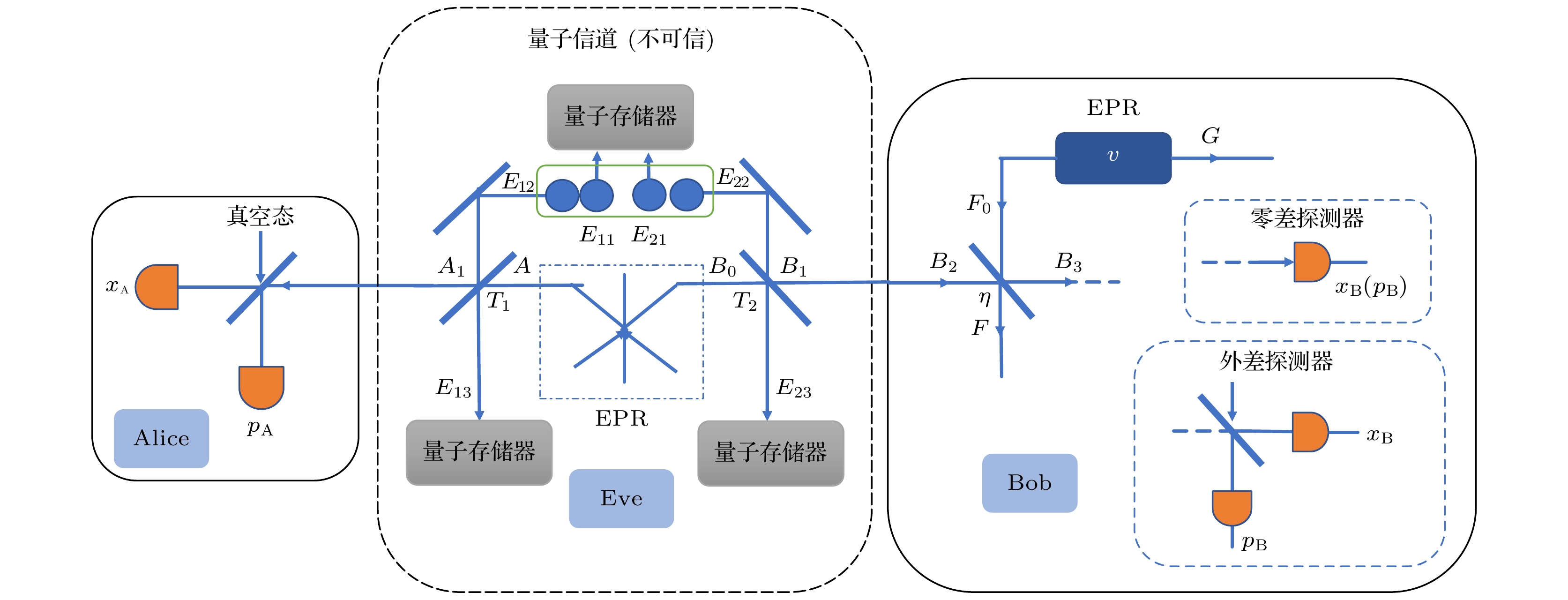
 下载:
下载:

